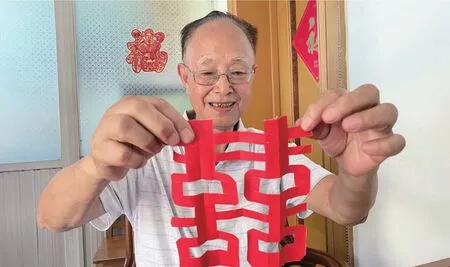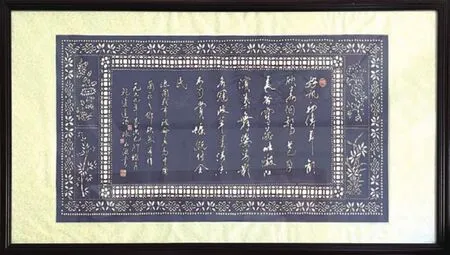剪下有世界 纸上见功夫
2023-01-31夏斌婷
文/夏斌婷

鲍运达。Bao Yunda.
印象里,小时候每逢喜庆之日,人们便会用剪窗花来表达内心丰富的情感。几张彩纸,一把剪刀,一双巧手,一幅幅色彩缤纷、栩栩如生的剪纸作品就会展现在眼前,给人以赏心悦目之感。
在金华,民间剪纸丰富多彩,风格各异。尤其是金华兰溪,二十世纪五六十年代之前,几乎每个村子都有几位被村民尊为“花师傅”的剪纸能手,他们走村串户、相互切磋,也互相竞争。令人感动的是,这些“花师傅”大都有一颗善良的心,有追求艺术精进的工匠精神。今年83岁的兰溪民间剪纸金华市级非物质文化代表性传承人鲍运达,正是如此。
村村有艺人
作为中国特有的集民俗性、趣味性、艺术性于一体的传统民间艺术,剪纸蕴藏了我国劳动人民深厚的情感,沉淀了几千年的华夏文化。至今仍在传承发展的中国剪纸艺术被誉为“活化石”,被联合国列入世界非物质文化遗产保护名录。
金华剪纸历史悠久,有记载的就有1500多年,兰溪民间剪纸的历史渊源已无从查考。但明代《武林梵志》记载的“城外百户,不张悬锦缎,皆用彩纸剪人马以代”,点出了江浙一带早就有剪纸艺术流行,侧面说明了属于吴越地带的兰溪民间剪纸亦应当有一段悠远的历史。
剪纸以镂剪、镌刻为手段,表现手法多样,画面对比鲜明,表现形式种类繁多,应用方式更是多种多样。过去的兰溪民间几乎村村都有剪纸艺人。兰溪剪纸与周边县市的风格有所区别,大都是作为装饰花、刺绣花样、民俗节日礼花、灯扎纸扎应用,形成了以幡扎“棂格花”为代表的原生态“祥瑞剪纸”的独特风格,具有鲜明的地方特色,至今仍在传承发展,显示出顽强的艺术生命力。
“幡扎窗花魅力滋,迎祥祈福焕新姿。精镂巧刻诚情掬,剪艺传承正有时。”多年来,定居兰溪的鲍运达为收集、抢救、整理民间剪纸,进行了广泛调研,积累了大量资料。
五大特色美
“你知道剪纸也分南北流派吗?这些流派都各有特色……浙江剪纸普及面广,题材多样……”提到剪纸,鲍运达就有说不完的话。他说,就风格而言,兰溪民间剪纸与毗邻的浦江、永康剪纸有所不同,后二者如戏曲窗花类,似朝“文人玩赏”方向发展,显得细柔俊美,有书卷气,极似明清绣像木刻版画,而兰溪民间剪纸则粗犷朴拙类占比较大,属于较原始的那种,与陕西安塞一带的剪纸异曲同工,“可以说属于‘原生态’剪纸”。
随着时代的演变,兰溪剪纸表现形式除单色外,还有染色、分色、衬色、绘色等多种形式,表现手法有阴刻、阳刻和阴阳结合三大类。同时,因兰溪剪纸独特的镂空技法,使其具有可双面同时欣赏的优点,体现了风格的淳朴美、手法的简洁美、构图的装饰美、造型的意象美、色彩的明快美五大特色美。
为什么会这么喜欢兰溪剪纸?“正是源于它的原生态之美。”鲍运达说,他少时跟随父母从安徽迁居兰溪,一直对当地的各种文艺活动很感兴趣。“20世纪50年代初,我读小学五年级时,姐姐从她教书的兰溪游埠镇节门张村带回几张剪纸。头一次见到这些不到巴掌大的精美‘花样’,我受到极大震撼,从此和剪纸结下了不解之缘。”
若干年后,18岁的鲍运达到文化站工作,开始收集民间剪纸和采集记录民歌,并一直坚持至今。他经常会带着孩子做剪纸手工,很受欢迎。
“学剪纸,一要有恒心有毅力,二要多看多练习。但想要在掌握基本技能的基础上创作出有自己独特风格的剪纸作品,就需要细细揣摩了。”改革开放后,民间剪纸受到重视,鲍运达摸索着学习剪纸知识和提升技艺,也慢慢地在剪纸艺术界有了立足之地。
2000年退休后,鲍运达更是专心扑到了剪纸这项爱好上,常常查资料、练习剪纸,一忙一整天。难得抽空和老伴出门旅游时,他总被景点的门窗木雕、石雕等迷住,只顾着拍照以致掉了队。
2003年11月,经被誉为“金华第一剪”的王风的多年努力,金华市民间文艺家协会剪纸艺术委员会正式成立,鲍运达任副会长兼秘书长。
因为协会活动,他与外地剪纸达人交流学习的机会增多,开始注重对兰溪剪纸这项非遗进行更加理论化的研究和总结。
边看边学,他先后将部分成果总结成《传统民间剪纸艺术初探》《民间剪纸与中国绘画之间的渊源关系管窥》等论文发表。在2006年发表的《兰溪“原生态”民间剪纸的艺术特性》一文中,鲍运达就对兰溪剪纸的应用范围、表现形式、特点、技艺等进行了深入的剖析。
同时,结合研究,鲍运达持续尝试创新题材和剪刻手法,如将兰溪当地的建筑、蓝印花布花样、风俗故事、书画作品等融入作品,收获大片好评。“你看墙上的这一幅作品,外圈我用的就是蓝印花布花样,里面则是自己创作的一首诗,主要用了蓝纸阴刻,很多人第一次看到还以为这是蓝印花布呢。”

鲍运达的剪纸作品。Paper-cutting work by Bao Yunda.
“有人会写不会剪,有人会剪不会写。鲍运达能剪会写爱创新,也很愿意培养新人,很是难得。”王风如是评价。据悉,今年新增的3位兰溪市剪纸非遗传承人中,有两位是鲍运达的学生。
传承贵创新
“剪纸是我热爱的事,剪纸技艺不仅是一种文化传承,也是一种精神传承。”对于鲍运达而言,推动兰溪剪纸传承发展,让这门技艺薪火相传,是作为非遗传承人的使命与责任。
为了更好地留住和传承这份手艺,2004年3月,鲍运达应邀在兰溪市老年大学开办剪纸教学班(后为剪纸联谊会)。多年来,剪纸班培养了一大批爱剪纸的老年人,还挖掘出一批中青年剪纸艺人。其3年间陆陆续续编写的讲义,也被汇编成了《中国剪纸与民俗文化》一书,作为校本教材流传至今。
但是让他觉得遗憾的是,长期以来,剪纸并不是一个可以谋生的行业。“虽然在学校里有所普及,却少有人愿意将其作为事业,专业化、规模化发展不足,以致传承势弱。”比如鲍运达持续关注着的兰溪河西一带的棂格剪纸,虽被不少人赞为“哭泣的艺术”,却因未受到重视,其图案和纹饰现已被电脑刻剪所代替。所幸,这一艺术近来受外国艺术家大加赞誉,一位青年剪纸传人在鲍运达的热心鼓励下,把棂格剪纸融入家传的无骨花灯制作,让其获得创新性发展。
“普通人常常会低估剪纸的价值,其实它蕴含着非常高深的审美水平和工艺技巧。剪纸的门槛很低,小到几岁的孩子稍加培训就能上手,但想要做好却很难。一件复杂的剪纸作品,少则要花数月,多则一年。”浙江省工艺美术大师、金华市剪纸博物馆馆长詹东明说,如何改变人们的固有观念,让金华剪纸的影响力更大,是他一直努力的方向。他创建金华市剪纸博物馆的初心也是基于此,希望哪怕多一个能让人了解剪纸艺术的平台。
确实,传承难似乎成了这一行的共性。兰溪市非物质文化遗产保护中心办公室主任陆颖异说,如今兰溪本地几位与剪纸相关的传承人所从事的工作,都与红白喜事紧密相关。“然而,剪纸用在民俗活动中有一定的局限性,只有结合生活用品才具有持久的生命力。”她说,大家也就此曾作过相关探讨,认为兰溪剪纸乃至金华剪纸技艺要永续传承,重点在于创新,可以从各类艺术设计中汲取养分,开发一些剪纸艺术相关的文创产品,赋予传统技艺新的生命力和活力。比如福建省南平市的浦城剪纸,传承人不仅推出了剪纸元素的瓷具、汉服、真皮手包等衍生系列产品,还与知名餐饮、茶叶等企业合作,与现代科技结合,将剪纸元素运用在餐饮、茶空间、农产品、数字艺术品等领域,开拓了剪纸创新发展之路。这些都是值得学习借鉴的。

鲍运达的剪纸作品。Paper-cutting work by Bao Yunda.

鲍运达收集的与剪纸有关的书籍。Books on paper-cutting that Bao Yunda has collected.
Making Stunning Art out of Paper
By Xia Binting
In my impression, whenever there was a festive occasion in the past, people would use paper-cutting to express their rich emotions. A few sheets of colored paper, a pair of scissors, and a pair of skillful hands would produce colorful and lifelike papercutting works in front of our eyes, giving us a pleasing sensation.
In Jinhua, folk paper-cutting is rich and colorful, with various styles. Particularly in Lianxi, before the 1950s and 1960s, almost every village had a few paper-cutting masters known as “flower masters” by the villagers, who would visit each other’s homes and compete. What is more moving is that these “flower masters” have a kind heart and a craftsman spirit of pursuing artistic excellence.Bao Yunda, 83 years old this year and a representative inheritor of Jinhua’s intangible cultural heritage of Lianxi folk paper-cutting, is such a person.
As a unique traditional folk art in China that combines folk customs, fun and art, paper-cutting embodies the deep emotions of China’s working people and has sedimented the culture of China for thousands of years. China’s paper-cutting art, which is still being inherited and developed, is known as a “living fossil”and has been included on the list of world intangible cultural heritage protected by the United Nations.
The history of Jinhua paper-cutting dates back more than 1,500 years, but the exact origins of Lianxi folk paper-cutting are untraceable. However, theWulin Fanzhi, a Buddhist gazetteer written in the Ming dynasty (1368-1644) recorded that “in the city’s suburbs, there are more than 100 households, none of which hang brocade and silk, all using colorful paper to cut horses and people instead”, indicating that paper-cutting art was popular in Jiangsu and Zhejiang, and suggesting that Lianxi folk papercutting in the Wu and Yue region should also have a long history.

鲍运达的剪纸作品。Paper-cutting work by Bao Yunda.

鲍运达的剪纸作品。Paper-cutting work by Bao Yunda.
Paper-cutting uses the techniques of carving and engraving to express a variety of hand movements, with contrasting images and a wide range of forms of expression. Its applications are also varied. In the past, almost every village in Lianxi had paper-cutting artists. Lianxi paper-cutting has a distinctive style compared to the surrounding counties and cities, mostly used as decorative flowers,embroidered patterns, folk festival flowers, and lamp paper. It has formed a unique style of original “auspicious paper-cutting”represented by “Lingge Flower” banners, with a distinct local character and a strong artistic vitality that is still being inherited and developed.
Over the years, Bao Yunda, after settling in Lianxi, has conducted extensive research on collecting, salvaging and organizing folk paper-cutting, and has accumulated a wealth of materials.
“Did you know that paper-cutting also has Northern and
Southern schools?These schools all have their own characteristics.Paper-cutting is widely popular in Zhejiang, with a variety of themes.In terms of style,folk paper-cutting in Lianxi is different from that in nearby Pujiang and Yongkang. The latter, such as opera window flowers, seems to be developing in the direction of ‘literati play and appreciation’, and is delicate and handsome,with a touch of scholarly elegance, much like Ming and Qing embroidered woodblock prints; folk paper-cutting in Lianxi is mostly rough and crude, belonging to the more primitive kind,similar to paper-cutting in Ansai, Shaanxi, and can be said to be primitive paper-cutting,” according to Bao.
With the evolution of the times, Lanxi’s paper-cutting has shown various forms of expression, including coloring, dividing into colors, lining and painting, as well as three main techniques: relief,intaglio, and a combination of the two. At the same time, Lanxi’s unique hollowing technique allows it to be appreciated on both side,showing its five characteristices of simplicity,concise technique,decorative composition, imagistic modeling and bright colors.
Why does Bao Yunda like Lanxi paper cutting so much?
“It’s because of its natural beauty,” Bao said. When he was young, he followed his parents to move to Lanxi from Anhui and has always been interested in various artistic activities in the local area."In the early 1950s,when I was in the fifth grade,my sister brought back some paper-cuttings from the Jiemeng Zhang village(Youbu town, Lanxi city) where she taught. Seeing these small,exquisite ‘patterns’ for the first time gave me a great shock and since then I have had a strong connection with paper-cutting.”
Several years later, the 18-year-old Bao started working at the Cultural Station and began collecting folk paper-cuttings and recording folk songs, which he has continued to do to this day.He often takes his children to do paper-cutting works, which are very popular. “Learning paper-cutting is not difficult, as long as you have patience and perseverance, and as long as you watch and practice a lot. However, to create paper cutting works with your own unique style on the basis of mastering basic skills, you need to study carefully.” After the Reform and Opening-Up, folk paper-cutting was given more attention, and Bao strived to learn and improve his knowledge and skills in paper-cutting, gradually establishing a foothold in the paper-cutting art world.
After retiring in 2000, Bao devoted himself even more to this hobby, often researching and practicing paper-cutting for a whole day. When he had a rare opportunity to travel abroad with his wife, he was always captivated by the wood and stone carvings on doors and windows at the tourist sites and would fall behind to take photos. In November 2003, the Paper-Cutting Art Committee of the Folk Art Association of Jinhua was Officially established,and Bao was appointed as vice chairman and secretary-general.
Because of his involvement in the association, he had more opportunities to exchange and learn from paper-cutters from other regions and began to focus more on the theoretical aspect of Lanxi paper-cutting as an intangible cultural heritage.
At the same time, based on his research, Bao has continued to try to innovate themes and cutting techniques, such as incorporating local architecture, blue-printed fabrics, folk customs and stories, and calligraphy and paintings into his works, and has received many positive reviews.
In order to better preserve and pass on this craft, in March 2004, Bao was invited to open a paper-cutting teaching class (later called the Paper-Cutting Association) at the Lanxi City College for the Elderly. Over the years, the paper-cutting class has trained a large number of elderly people who love paper-cutting and has also unearthed a group of young and middle-aged paper-cutting artists.The lecture notes he created and collected over the three years have also been compiled into a book calledChinese Paper-Cutting and Folk Culture, which has been used as a textbook to this day.
However, Bao regrets that paper-cutting has not been a sustainable industry for a long time. “Although it is popular in schools, few people are willing to make it their career, and there is insufficienr professionalization and scale development,resulting in weak inheritance,” he said.
Indeed, the difficulty of preserving this craft seems to be a commonality in this field. For Lanxi paper-cutting and even Jinhua paper-cutting skills to be sustained, the key is innovation. It is possible to draw inspiration from various types of art and design to develop cultural and creative products related to paper-cutting art, injecting new life and vitality to traditional skills.

鲍运达的剪纸作品。Paper-cutting work by Bao Yunda.
